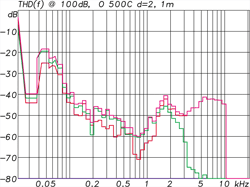zephyr24069 and I have a different perspective than most all audiophiles, as we are both musicians (I've also been a trumpet player most of my life), and want to reproduce the realism of being "in" the orchestra, not what you would hear seated in the 20th row/ far from the impact zone of real world dynamics. The large orchestral drum wallops in the Telarc CD Trittico are centered close to 28z. Only when you have sat 3 feet in front of one of them, does your frame of reference forever change. Being a former drummer, once you sit behind a set of drums, or play in a band where you feel every note on stage ,not just hear it, you want to replicate that percussive effect with your stereo. Displacement is where percussive effect comes from, very simple physics. Small audiophile subs (REL, JL 112, etc). with limited displacement(please, no flames from the owners of these subs), will give you limited bass extension and dynamic slam. Same with pipe organ music. I worked as a pipe organ builder for 7 years. Going back home and trying to reproduce a recorded concert reveals system deficiencies. The myth in audio is that the bigger the subwoofer, the slower/mushy the bass is, but it is actually the inductance of the driver that determines tightness/accuracy. Interesting paper on this subject written by Dan Wiggins ( world famous speaker designer) :
http://www.yildiz.edu.tr/~ilkorur/WooferSpeed.pdf
Everyone likes a different sound though and has different taste in music, and 90% of the people have limited budgets to work with. Just like going from room to room at the CES Show, the high efficiency/tube guys from Japan would not play my Telarc pipe organ recordings as they knew their 6 1/2" woofers would bottom out, and burn up their voice coils with a 16z note held for 30 seconds Bach piece. Or the guy at Ocean Way sound with his 30K speakers that I got to bottom out the woofers on my first song. But to have a system that will reproduce ALL aspects of live music, sufficient displacement must be available.







